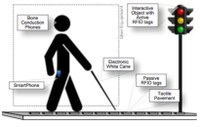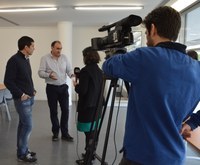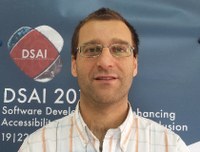INESC TEC wants to increase e-Inclusion and autonomy of the blind with mobile digital platform
Project ce4blind starts in May
Increasing the autonomy of the blind or people with low vision, allowing them to be included in a large set of activities and improving their quality of life, using a mobile digital platform – this is INESC TEC’s goal with project CE4BLIND (Context Extraction for the blind using computer vision), which starts in May and will last 12 months.


System will feature the most recent image capturing technology and 3D printing
Project CE4BLIND will feature the most recent technologies, benefiting from the latest developments in mobile devices and miniaturised cameras, such as Project Tango, SmartEyeglass, or smartphones with personalised apps.
“Automatically reading books, magazines, restaurant menus or food packages, using computer vision techniques, will be some of the functionalities featured in this platform. The goal is to obtain a digital intelligent support platform, improving e-inclusion, and making users feel integrated and productive in a digital society,” explains João Barroso, researcher at INESC TEC’s Centre for Information Systems and Computer Graphics (CSIG).


Besides these computer vision techniques, new forms of interpreting 3D data in static and moving objects will be explored. Haptic interfaces and tactile objects can be created from the respective models acquired from the real world. This way, the goal is to improve the perception of the real world of the visually impaired.
The platform will be designed with a natural, non-invasive interface that will be used according to each user’s needs and limitations, without having to change their habits and routines.


University of Texas and ACAPO are partners
This research line started being pursued in 2008 with project SmartVision, where the goal is to provide visually impaired users a set of instructions on how to get to a certain destination, and simultaneously warn them on nearby obstacles and points of interest, including pedestrian crossings, stairs and building entrances.
The following project in this area was Blavigator, where the goal was to continue the work which started with SmartVision, and create a navigation system for the visually impaired that can be commercialised.


“With Blavigator we developed an electronic cane to help the visually impaired move about, and an app that makes it possible to obtain geographical information using a mobile phone. The cane has an antenna, a radio frequency identifier (RFID), and all the electronic components that make it possible to read the identifiers. These identifiers can be put on public roads or in buildings , working as a source of information that is transmitted to the user through the system,” explains Hugo Paredes, researcher at INESC TEC.


The CE4BLIND is the most recent project in this area.
The INESC TEC team participating in this project is composed of João Barroso, Vítor Filipe, Hugo Paredes and Hugo Ricardo Fernandes from CSIG.
The INESC TEC researchers mentioned in this article are associated with the following partner institutions: UTAD and INESC Porto.


